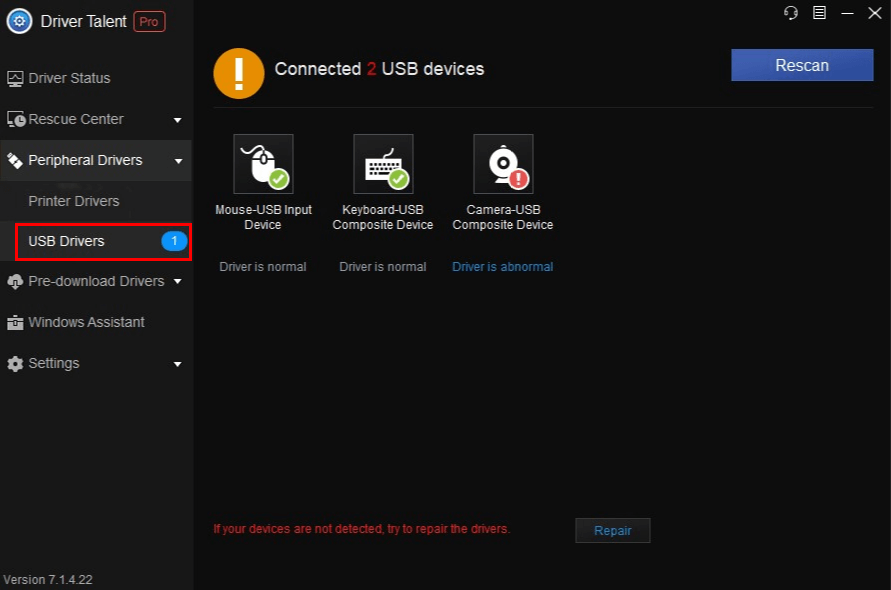Click the driver to view the supported device name for the selected driver. The network device name (result from Section 1) should match with the information listed in the driver page (for example, Intel Dual Band Wireless-AC 7260). If the network device name matches, then download the driver as per the instructions in the driver page. See the release notes and the readme.txt file for installation instructions, supported hardware, what's new, bug fixes, and known issues. This download installs base drivers, Intel® PROSet for Windows. Device Manager, and Intel® PROSet Adapter Configuration Utility for Intel® Network Adapters with Windows® 10.

Usb Network Joystick Download
Download Usb Network Driver
With state-of-the-art DSP technology and mixed-mode signal technology, the RTL8153 offers high-speed transmission over CAT 5 UTP cable or CAT 3 UTP (10Mbps only) cable. Functions such as Crossover Detection and Auto-Correction, polarity correction, adaptive equalization, cross-talk cancellation, echo cancellation, timing recovery, and error correction are implemented to provide robust transmission and reception capabilities. The RTL8153 features embedded One-Time-Programmable (OTP) memory that can replace the external EEPROM (93C46/93C56/93C66/TWSI).

What's New:
- Windows 10 version 10.10
- Windows 8 version 8.31
- Windows 7 version 7.24
- Windows Vista version 6.13
- Windows XP version 5.9
The RTL8153 features USB 3.0 to provide higher bandwidth and improved protocols for data exchange between the host and the device. USB 3.0 also offers more advanced power management features for energy saving.
Advanced Configuration Power management Interface (ACPI)—power management for modern operating systems that are capable of Operating System-directed Power Management (OSPM)—is supported to achieve the most efficient power management possible. In addition to the ACPI feature, remote wake-up (including AMD Magic Packet and Microsoft Wake-Up Frame) is supported in both ACPI and APM (Advanced Power Management) environments.
The RTL8153 supports Microsoft Wake Packet Detection (WPD) to provide Wake-Up Frame information to the OS, e.g., PatternID, OriginalPacketSize, SavedPacketSize, SavedPacketOffset, etc. WPD helps prevent unwanted/unauthorized wake-up of a sleeping computer.

The RTL8153 supports ‘RealWoW!’ technology to enable remote wake-up of a sleeping PC through the Internet. This feature allows PCs to reduce power consumption by remaining in low power sleeping state until needed.
Note: The ‘RealWoW!’ service requires registration on first time use.
The RTL8153 supports Protocol offload. It offloads some of the most common protocols to NIC hardware in order to prevent spurious wake-up and further reduce power consumption. The RTL8153 can offload ARP (IPv4) and NS (IPv6) protocols while in the D3 power saving state.
The RTL8153 supports the ECMA (European Computer Manufacturers Association) proxy for sleeping hosts standard. The standard specifies maintenance of network connectivity and presence via proxies in order to extend the sleep duration of higher-powered hosts. It handles some network tasks on behalf of the host, allowing the host to remain in sleep mode for longer periods. Required and optional behavior of an operating proxy includes generating reply packets, ignoring packets, and waking the host.
The RTL8153 supports IEEE 802.3az-2010, also known as Energy Efficient Ethernet (EEE). IEEE 802.3az-2010 operates with the IEEE 802.3 Media Access Control (MAC) Sublayer to support operation in Low Power Idle mode. When the Ethernet network is in low link utilization, EEE allows systems on both sides of the link to save power.

The RTL8153 is fully compliant with Microsoft NDIS5, NDIS6 (IPv4, IPv6, TCP, UDP) Checksum features, and supports IEEE 802 IP Layer 2 priority encoding and IEEE 802.1Q Virtual bridged Local Area Network (VLAN). The above features contribute to lowering CPU utilization, especially benefiting performance when in operation on a network server.
The RTL8153 is suitable for multiple market segments and emerging applications, such as desktop, mobile, workstation, server, communications platforms, docking station, and embedded applications.
Features:
- Hardware
- Integrated 10/100/1000M transceiver
- Auto-Negotiation with Next Page capability
- Supports USB 3.0, 2.0, and 1.1
- Supports CDC-ECM
- Supports LPM (Link Power Management)
- Supports pair swap/polarity/skew correction
- Crossover Detection & Auto-Correction
- Supports Wake-On-LAN and ‘RealWoW!’ (Wake-On-WAN) Technology
- Supports ECMA-393 ECMA ProxZzzy Standard for sleeping hosts
- XTAL-Less Wake-On-LAN
- Supports power down/link down power saving
- Transmit/Receive on-chip buffer support
- EEPROM Interface
- Embedded OTP memory can replace external EEPROM
- Built-in switching regulator and LDO regulator
- Supports Customizable LEDs
- Supports hardware CRC (Cyclic Redundancy Check) function
- LAN disable with GPIO pin
- Supports 25MHz or 48MHz external clock (from oscillator or system clock source)
- SPI Flash Interface
- 48-pin QFN ‘Green’ package
Download Previous Versions:
 Here's other similar drivers that are different versions or releases for different operating systems:
Here's other similar drivers that are different versions or releases for different operating systems: - January 2, 2019
- Windows (all)
- 10.3 MB
- January 2, 2019
- Windows (all)
- 10.3 MB
- July 30, 2018
- Windows 7
- 10.6 MB
- July 5, 2017
- Windows (all)
- 10.1 MB
- July 12, 2017
- Windows (all)
- 10.2 MB
- May 10, 2017
- Windows (all)
- 10.2 MB
- March 23, 2017
- Windows 7/8/10
- 10.1 MB
- May 10, 2017
- Windows 8
- 9.3 MB
- May 10, 2017
- Windows (all)
- 9.4 MB
- January 20, 2017
- Windows (all)
- 10.0 MB
